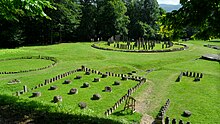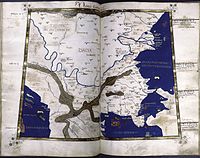Dacia
Dacia (/ˈdeɪʃə/, DAY-shə; Latin: [ˈd̪aː.ki.a]) was the land inhabited by the Dacians, its core in Transylvania, stretching to the Danube in the south, the Black Sea in the east, and the Tisza in the west.
A group of "Free Dacians" may have remained outside the Roman Empire in the territory of modern-day Northern Romania until the start of the Migration Period.
[2] Some historians argue that Daxia (mentioned in 3rd century BC) was the previous home of Indo-Iranian nomads[3] who later came to form the Geto-Dacian people.
[7] During that period, the Getae and Dacians conquered a wider territory and Dacia extended from the Middle Danube to the Black Sea littoral (between Apollonia and Pontic Olbia) and from the Northern Carpathians to the Balkan Mountains.
[8] After the death of Burebista in 44 BCE, his Kingdom quickly unraveled, but the Dacians remained a significant enough force to frequently make incursions into Roman territory.
[1] Strabo, in his Geography written around AD 20, says:[9] ″As for the southern part of Germany beyond the Albis, the portion which is just contiguous to that river is occupied by the Suevi; then immediately adjoining this is the land of the Getae, which, though narrow at first, stretching as it does along the Ister [Danube] on its southern side and on the opposite side along the mountain-side of the Hercynian Forest (for the land of the Getae also embraces a part of the mountains), afterwards broadens out towards the north as far as the Tyregetae; but I cannot tell the precise boundaries″On this basis, Lengyel and Radan (1980), Hoddinott (1981) and Mountain (1998) consider that the Geto-Dacians inhabited both sides of the Tisza river prior to the rise of the Celtic Boii.
[13] In the 1st century AD, the Iazyges settled West of Dacia, on the plain between the Danube and the Tisa rivers, according to the scholars' interpretation of Pliny's text: "The higher parts between the Danube and the Hercynian Forest as far as the winter quarters of Pannonia at Carnutum and the plains and level country of the German frontiers there are occupied by the Sarmatian Iazyges, while the Dacians whom they have driven out hold the mountains and forests as far as the river Theiss".
According to the scholars' interpretation of Ptolemy (Hrushevskyi 1997, Bunbury 1879, Mocsy 1974, Bărbulescu 2005) Dacia was the region between the rivers Tisza, Danube, upper Dniester, and Siret.
[23][24][25][26][27] Ptolemy also provided a couple of Dacian toponyms in south Poland in the Upper Vistula (Polish: Wisla) river basin: Susudava and Setidava (with a manuscript variant Getidava).
Geto-Dacians inhabited both sides of the Tisa river prior to the rise of the Celtic Boii and again after the latter were defeated by the Dacians under the king Burebista.
He thoroughly reorganised the army and attempted to raise the moral standard and obedience of the people by persuading them to cut their vines and give up drinking wine.
The Bastarnae and Boii were conquered, and even the Greek towns of Olbia and Apollonia on the Black Sea (Pontus Euxinus) recognized Burebista's authority.
[24] Burebista suppressed the indigenous minting of coinages by four major tribal groups, adopting imported or copied Roman denarii as a monetary standard.
Strabo testified: "although the Getae and Daci once attained to very great power, so that they actually could send forth an expedition of two hundred thousand men, they now find themselves reduced to as few as forty thousand, and they have come close to the point of yielding obedience to the Romans, though as yet they are not absolutely submissive, because of the hopes which they base on the Germans, who are enemies to the Romans.
[47] The next year, AD 88, new Roman troops under Tettius Julianus, gained a significant advantage, but were obligated to make peace following the defeat of Domitian by the Marcomanni, leaving the Dacians effectively independent.
To Rome, Domitian brought Italian peasants in Dacian clothing because he couldn't take slaves in the war.
[48] To increase the glory of his reign, restore the finances of Rome, and end a treaty perceived as humiliating, Trajan resolved on the conquest of Dacia, the capture of the famous Treasure of Decebalus, and control over the Dacian gold mines of Transylvania.
Rome's borders in the east were governed indirectly in this period, through a system of client states, which led to less direct campaigning than in the west.
Additionally, the conquest changed the balance of power in the region and was the catalyst for a renewed alliance of Germanic and Celtic tribes and kingdoms against the Roman Empire.
In AD 183, war broke out in Dacia: few details are available, but it appears two future contenders for the throne of emperor Commodus, Clodius Albinus and Pescennius Niger, both distinguished themselves in the campaign.
Even so, the Germanic and Celtic kingdoms, particularly the Gothic tribes, slowly moved toward the Dacian borders, and within a generation were making assaults on the province.
The weather and lack of food cost the Goths dearly: reportedly, nearly one hundred thousand died before they submitted to Rome.
[70] The territory between the Lower Danube and the Black Sea (today Dobrogea in Romania) remained a fully integrated part of the Roman Empire, even after the abandonment of Trajan's Dacia.
[74][75] Under Emperor Constantine the Great (306–337), a bridge across the Danube was constructed at Sucidava, a new fort (Constantiana Daphne) was built, and ancient roads were repaired in Oltenia.
[76][77] The Lower Danube again became the empire's northern boundary in 369 at the latest, when Emperor Valens met Athanaric—the head of the Goths—in a boat in the middle of the river because the latter had taken an oath "never to set foot on Roman soil".
[78][79] Although Eastern Roman emperors made annual payments to the neighboring peoples in an attempt to keep the peace in the Balkans, the Avars regularly invaded Scythia Minor from the 580s.
[86] On the other hand, evidence – mainly pottery with "Chi-rho" (Χ-Ρ) signs and other Christian symbols – is "shadowy and poorly understood", according to archaeologists Haynes and Hanson.
[87] Urns found in late 3rd-century cemeteries at Bezid, Mediaş, and in other Transylvanian settlements had clear analogies in sites east of the Carpathians, suggesting that the Carpians were the first new arrivals in the former province from the neighboring regions.
Please improve this section by adding reliable sources] The Victohali, Taifals, and Thervingians are tribes mentioned for inhabiting Dacia in 350, after the Romans left.
Lombards abandoned the country and the Avars (second half of the 6th century) dominated the region for 230 years, until their kingdom was destroyed by Charlemagne in 791.












